Abstract
2,3,7,8-Tetrachlorodibenzo-p-dioxin (TCDD) is the most potent member of a class of chlorinated hydrocarbons that interact with the aryl hydrocarbon receptor (AhR). TCDD and dioxinlike compounds are environmentally and biologically stable and as a result, human exposure is chronic and widespread. Studies of highly exposed human populations show that dioxins produce developmental effects, chloracne, and an increase in all cancers and suggest that they may also alter immune and endocrine function. In contrast, the health effects of low-level environmental exposure have not been established. Experimental animal models can enhance the understanding of the effects of low-level dioxin exposure, particularly when there is evidence that humans respond similarly to the animal models. Although there are species differences in pharmacokinetics, experimental animal models demonstrate AhR-dependent health effects that are similar to those found in exposed human populations. Comparisons of biochemical changes show that humans and animal models have similar degrees of sensitivity to dioxin-induced effects. The information gained from animal models is important for developing mechanistic models of dioxin toxicity and critical for assessing the risks to human populations under different circumstances of exposure.
Full text
PDF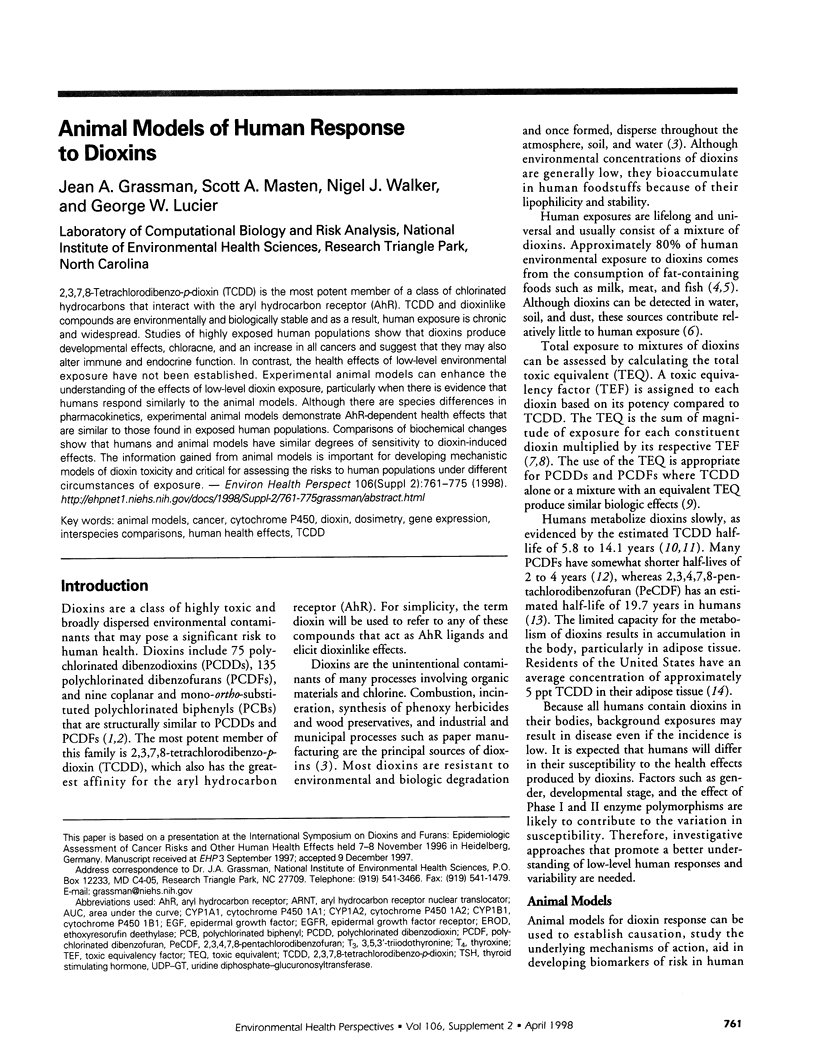
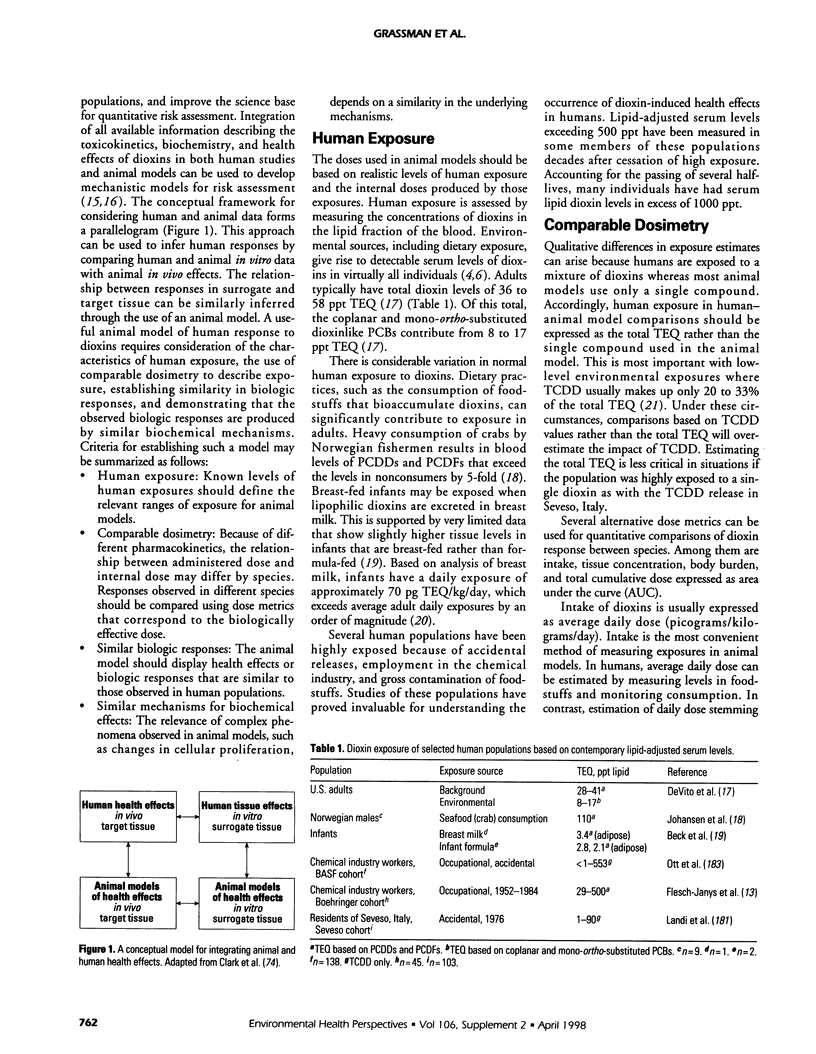
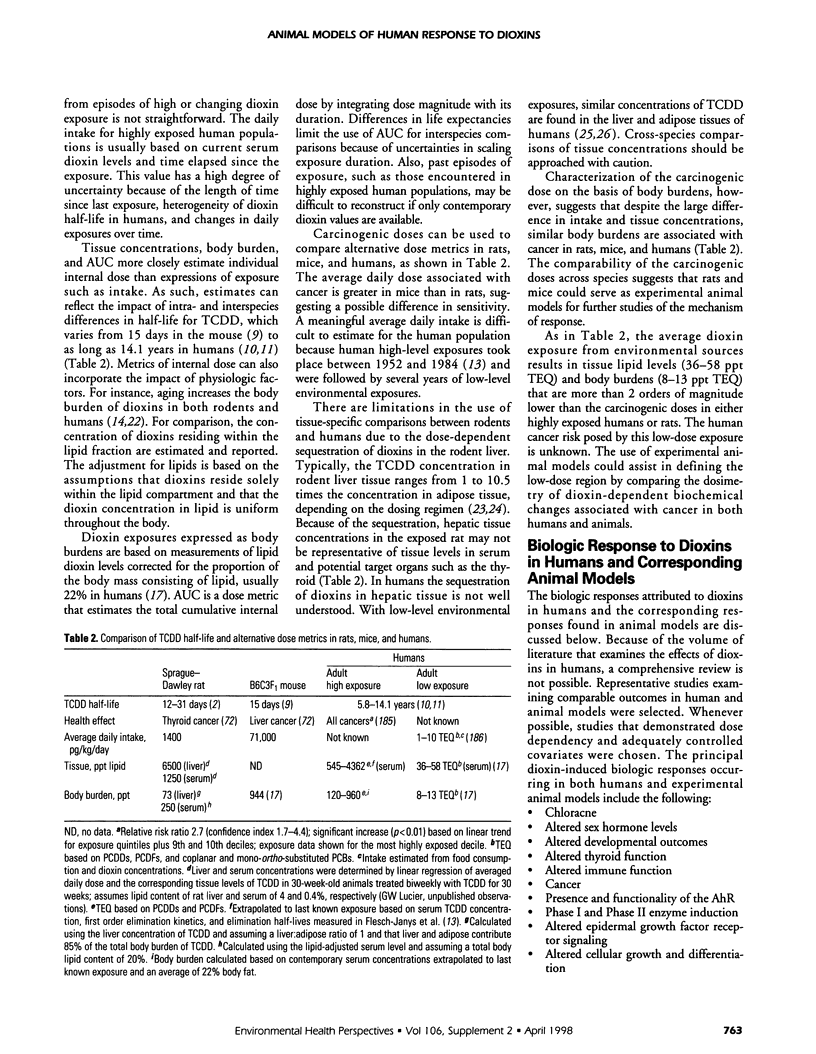

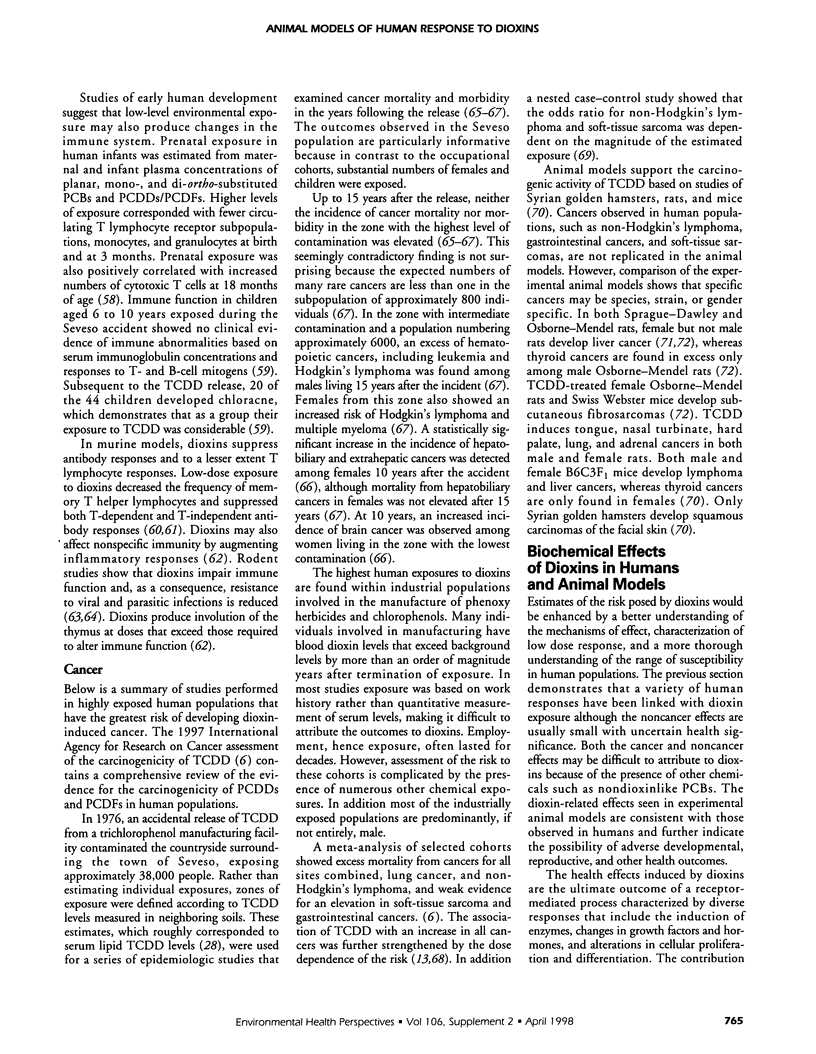
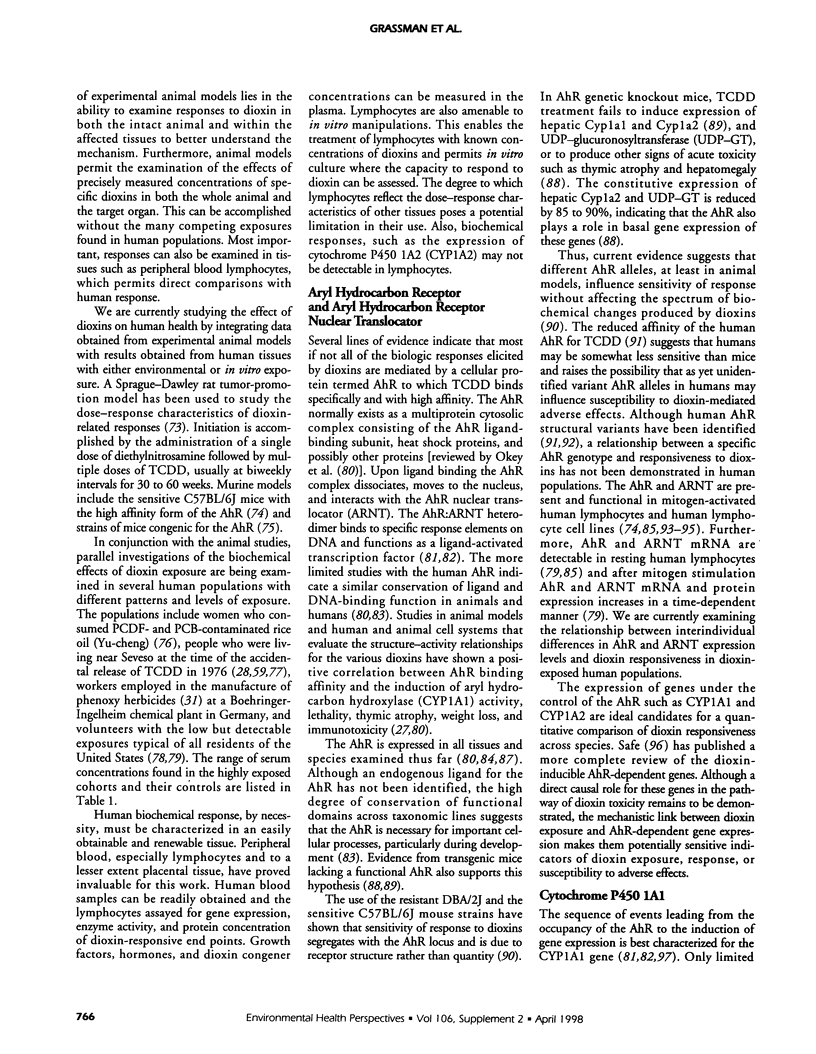
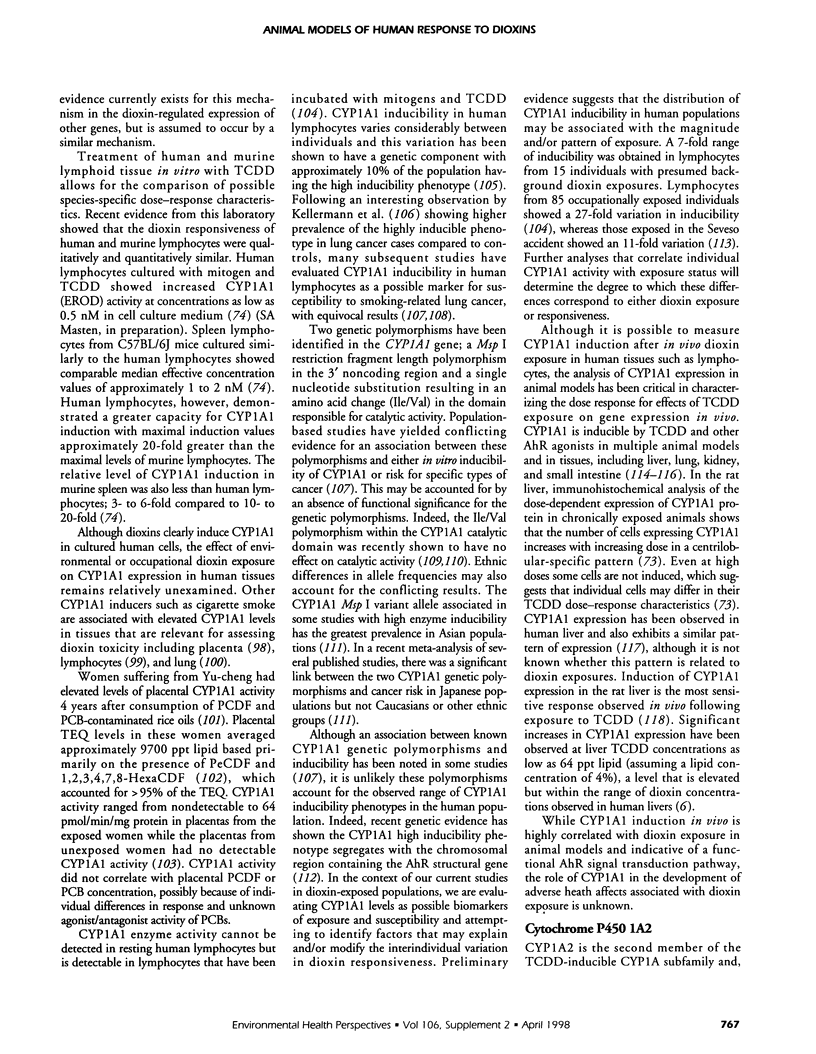
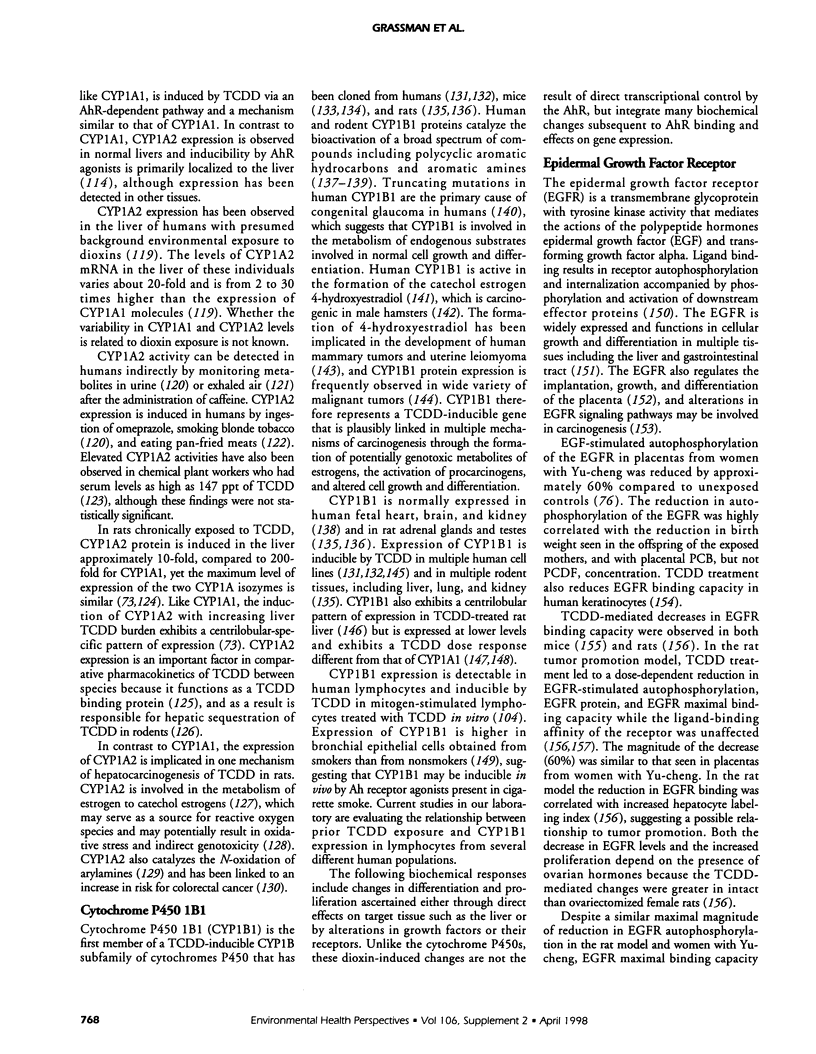
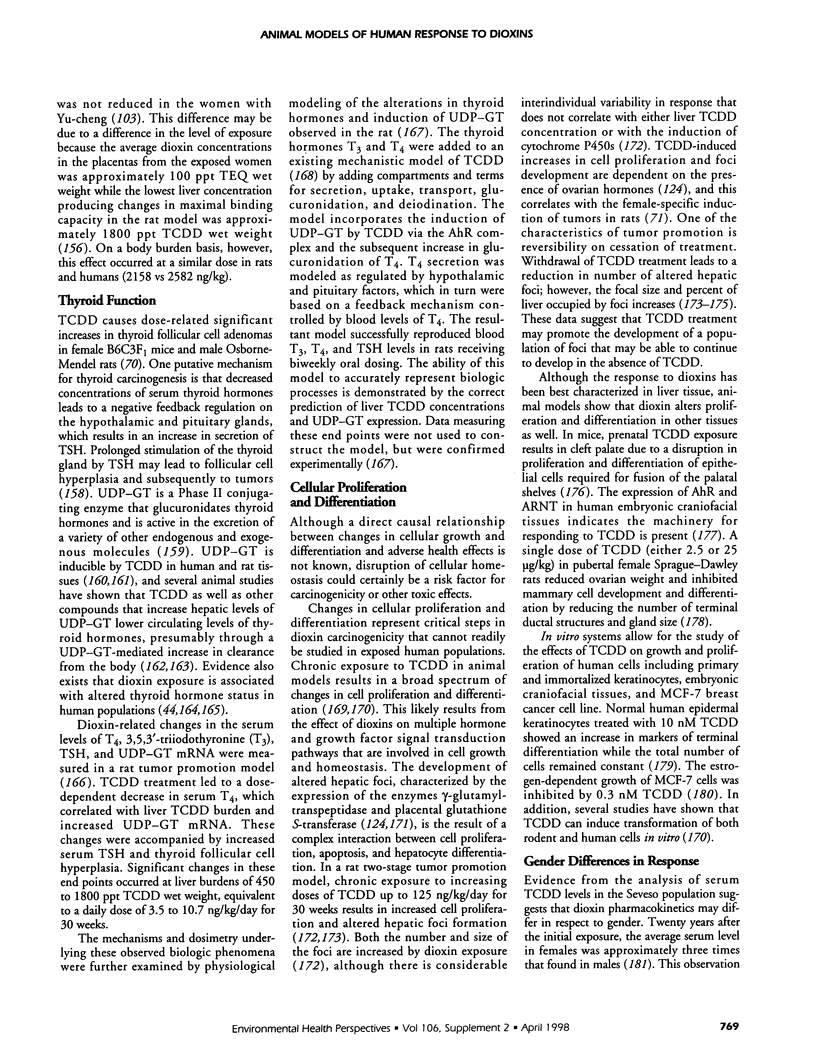
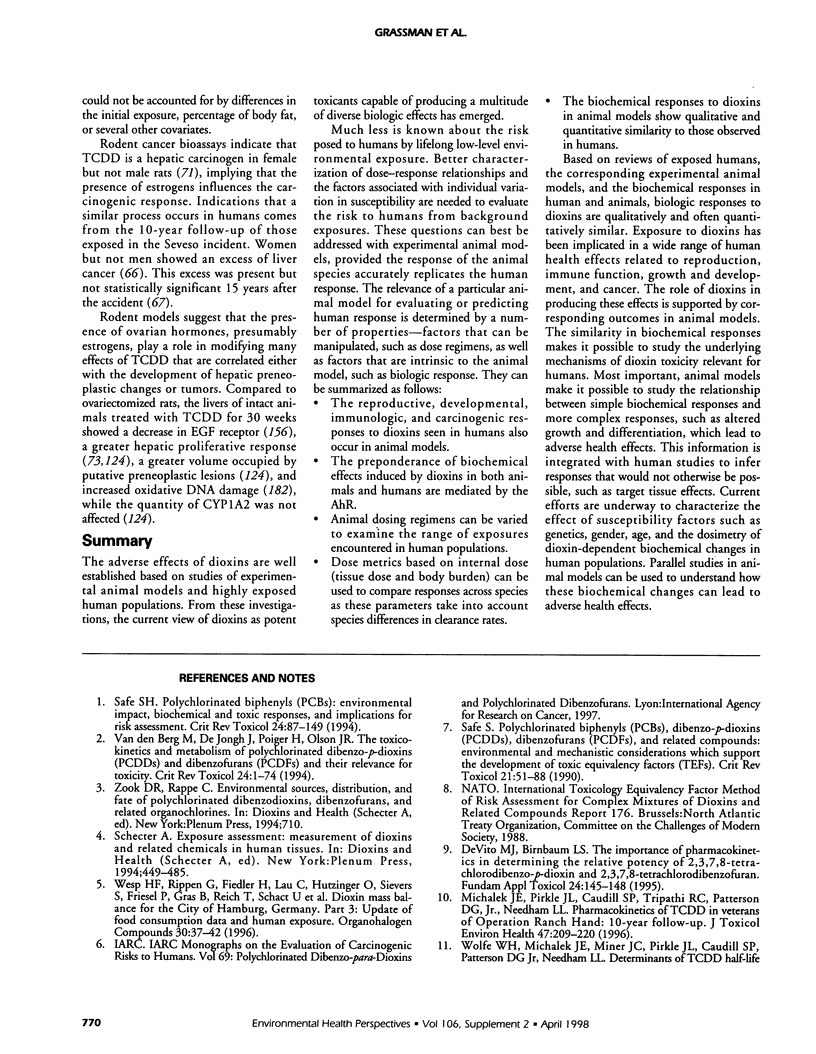
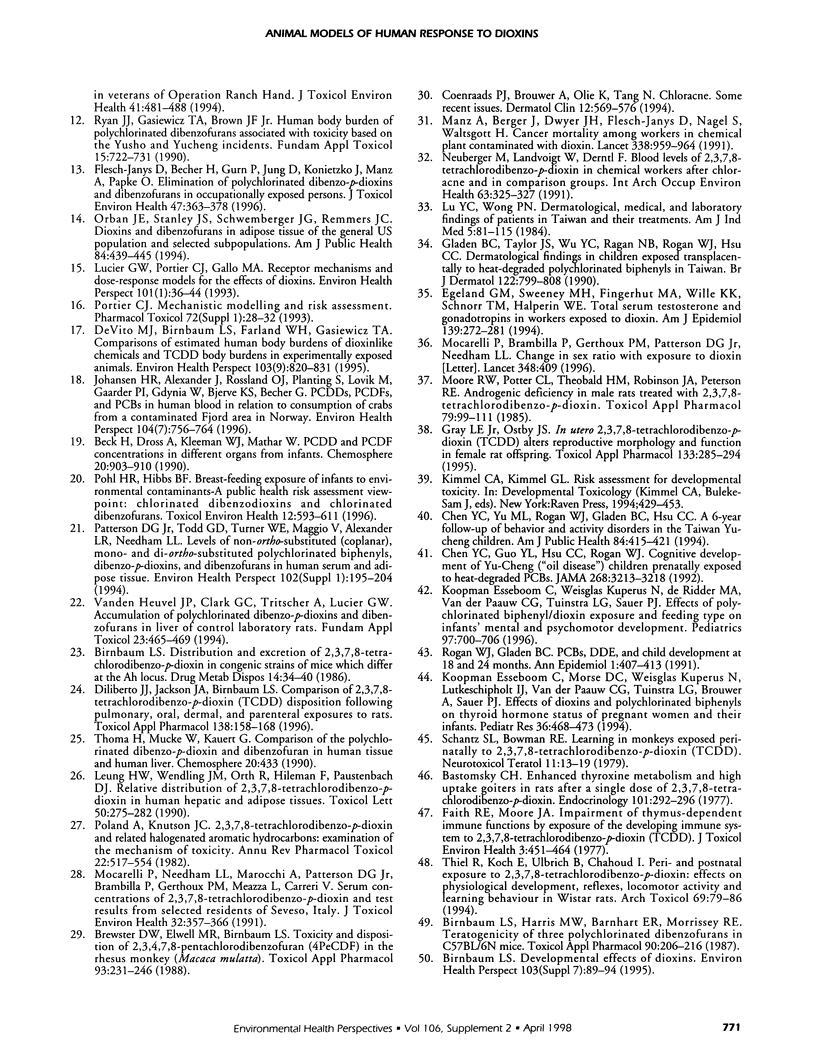
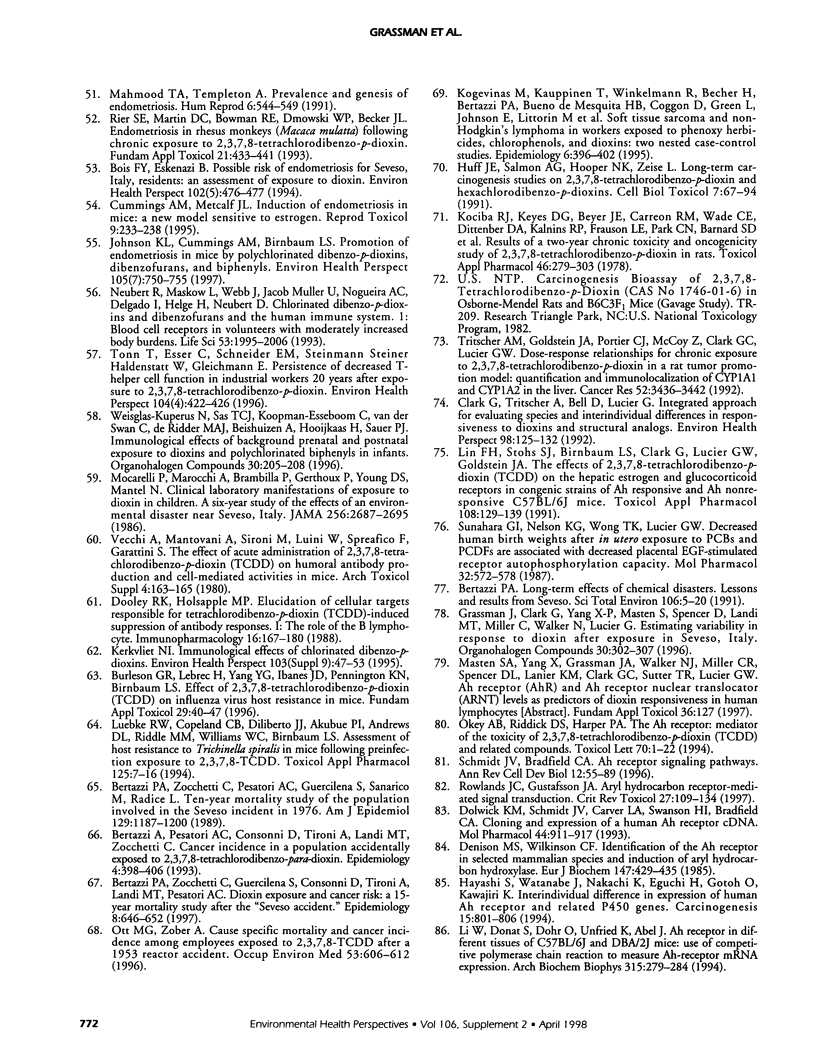
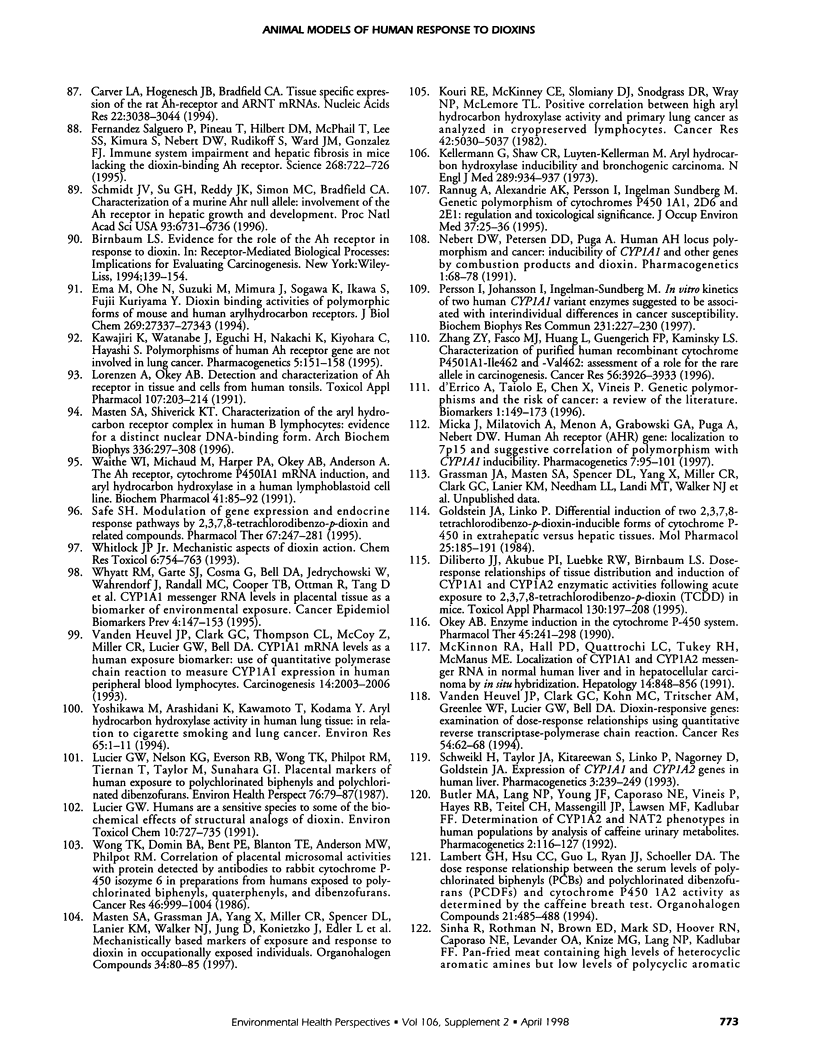
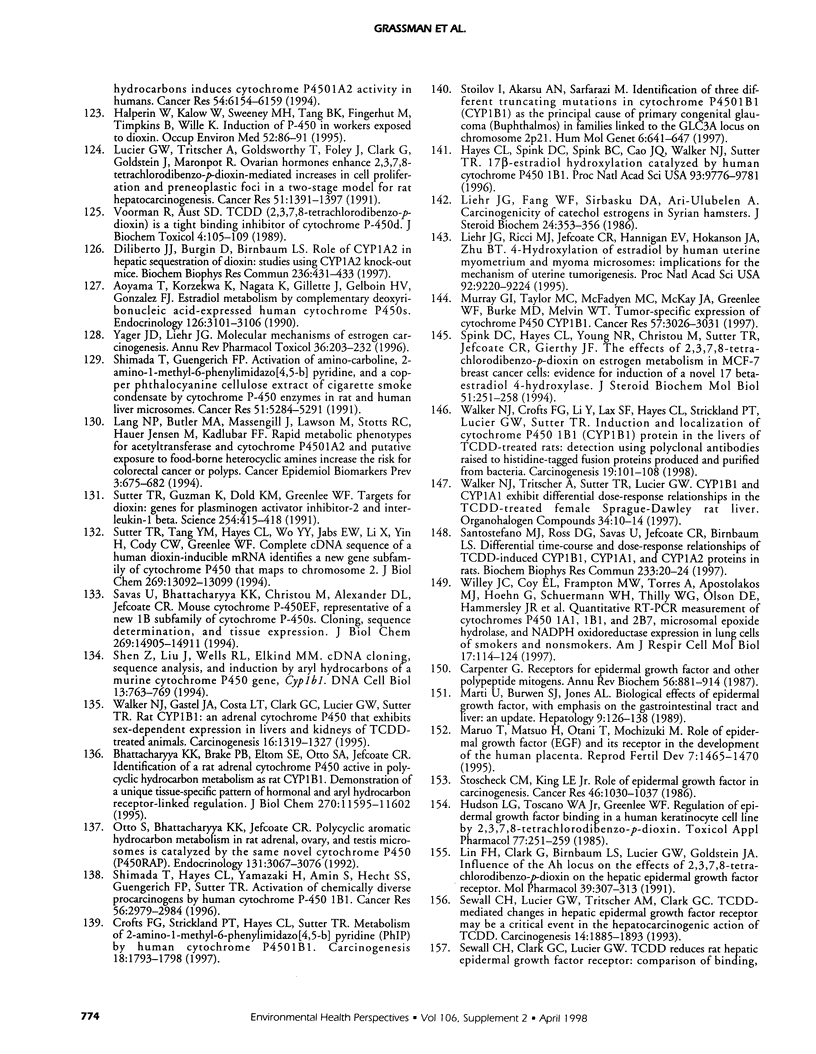
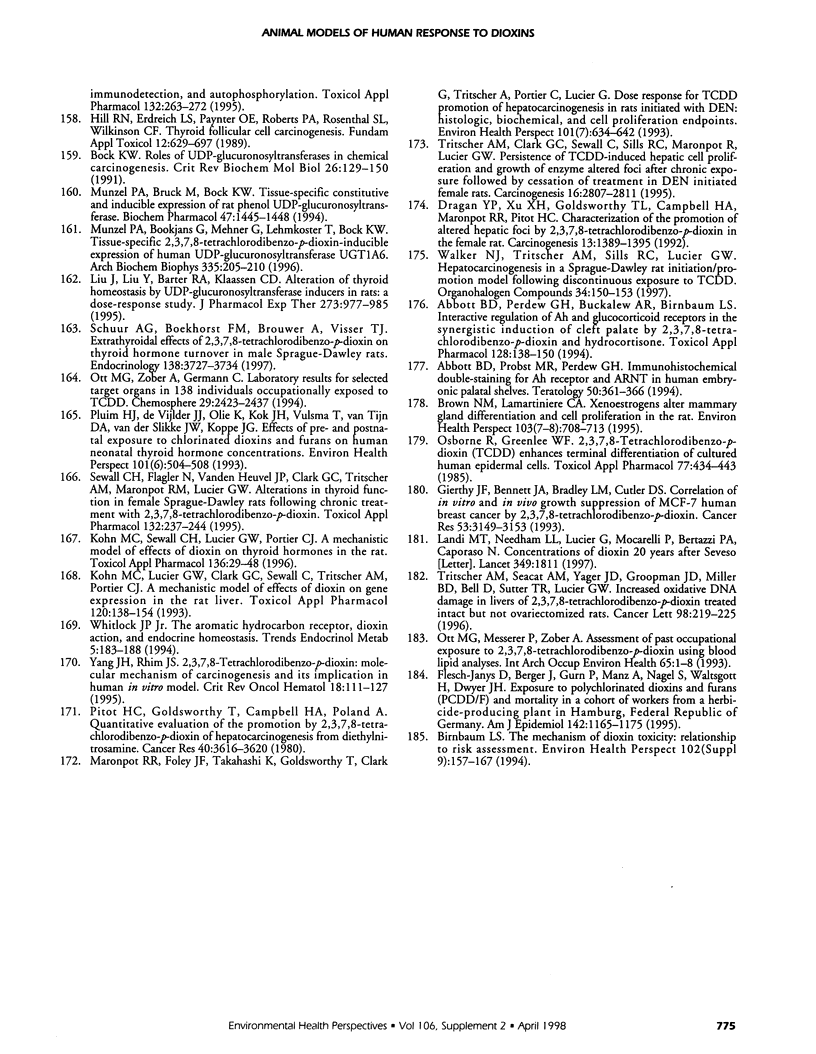
Selected References
These references are in PubMed. This may not be the complete list of references from this article.
- Abbott B. D., Perdew G. H., Buckalew A. R., Birnbaum L. S. Interactive regulation of Ah and glucocorticoid receptors in the synergistic induction of cleft palate by 2,3,7,8-tetrachlorodibenzo-p-dioxin and hydrocortisone. Toxicol Appl Pharmacol. 1994 Sep;128(1):138–150. doi: 10.1006/taap.1994.1191. [DOI] [PubMed] [Google Scholar]
- Abbott B. D., Probst M. R., Perdew G. H. Immunohistochemical double-staining for Ah receptor and ARNT in human embryonic palatal shelves. Teratology. 1994 Nov;50(5):361–366. doi: 10.1002/tera.1420500507. [DOI] [PubMed] [Google Scholar]
- Aoyama T., Korzekwa K., Nagata K., Gillette J., Gelboin H. V., Gonzalez F. J. Estradiol metabolism by complementary deoxyribonucleic acid-expressed human cytochrome P450s. Endocrinology. 1990 Jun;126(6):3101–3106. doi: 10.1210/endo-126-6-3101. [DOI] [PubMed] [Google Scholar]
- Bastomsky C. H. Enhanced thyroxine metabolism and high uptake goiters in rats after a single dose of 2,3,7,8-tetrachlorodibenzo-p-dioxin. Endocrinology. 1977 Jul;101(1):292–296. doi: 10.1210/endo-101-1-292. [DOI] [PubMed] [Google Scholar]
- Bertazzi A., Pesatori A. C., Consonni D., Tironi A., Landi M. T., Zocchetti C. Cancer incidence in a population accidentally exposed to 2,3,7,8-tetrachlorodibenzo-para-dioxin. Epidemiology. 1993 Sep;4(5):398–406. doi: 10.1097/00001648-199309000-00004. [DOI] [PubMed] [Google Scholar]
- Bertazzi P. A. Long-term effects of chemical disasters. Lessons and results from Seveso. Sci Total Environ. 1991 Jul 1;106(1-2):5–20. doi: 10.1016/0048-9697(91)90016-8. [DOI] [PubMed] [Google Scholar]
- Bertazzi P. A., Zocchetti C., Guercilena S., Consonni D., Tironi A., Landi M. T., Pesatori A. C. Dioxin exposure and cancer risk: a 15-year mortality study after the "Seveso accident". Epidemiology. 1997 Nov;8(6):646–652. [PubMed] [Google Scholar]
- Bertazzi P. A., Zocchetti C., Pesatori A. C., Guercilena S., Sanarico M., Radice L. Ten-year mortality study of the population involved in the Seveso incident in 1976. Am J Epidemiol. 1989 Jun;129(6):1187–1200. doi: 10.1093/oxfordjournals.aje.a115240. [DOI] [PubMed] [Google Scholar]
- Bhattacharyya K. K., Brake P. B., Eltom S. E., Otto S. A., Jefcoate C. R. Identification of a rat adrenal cytochrome P450 active in polycyclic hydrocarbon metabolism as rat CYP1B1. Demonstration of a unique tissue-specific pattern of hormonal and aryl hydrocarbon receptor-linked regulation. J Biol Chem. 1995 May 12;270(19):11595–11602. doi: 10.1074/jbc.270.19.11595. [DOI] [PubMed] [Google Scholar]
- Birnbaum L. S. Developmental effects of dioxins. Environ Health Perspect. 1995 Oct;103 (Suppl 7):89–94. doi: 10.1289/ehp.95103s789. [DOI] [PMC free article] [PubMed] [Google Scholar]
- Birnbaum L. S. Distribution and excretion of 2,3,7,8-tetrachlorodibenzo-p-dioxin in congenic strains of mice which differ at the Ah locus. Drug Metab Dispos. 1986 Jan-Feb;14(1):34–40. [PubMed] [Google Scholar]
- Birnbaum L. S., Harris M. W., Barnhart E. R., Morrissey R. E. Teratogenicity of three polychlorinated dibenzofurans in C57BL/6N mice. Toxicol Appl Pharmacol. 1987 Sep 15;90(2):206–216. doi: 10.1016/0041-008x(87)90328-0. [DOI] [PubMed] [Google Scholar]
- Birnbaum L. S. The mechanism of dioxin toxicity: relationship to risk assessment. Environ Health Perspect. 1994 Nov;102 (Suppl 9):157–167. doi: 10.1289/ehp.94102s9157. [DOI] [PMC free article] [PubMed] [Google Scholar]
- Bock K. W. Roles of UDP-glucuronosyltransferases in chemical carcinogenesis. Crit Rev Biochem Mol Biol. 1991;26(2):129–150. doi: 10.3109/10409239109081125. [DOI] [PubMed] [Google Scholar]
- Bois F. Y., Eskenazi B. Possible risk of endometriosis for Seveso, Italy, residents: an assessment of exposure to dioxin. Environ Health Perspect. 1994 May;102(5):476–477. doi: 10.1289/ehp.94102476. [DOI] [PMC free article] [PubMed] [Google Scholar]
- Brewster D. W., Elwell M. R., Birnbaum L. S. Toxicity and disposition of 2,3,4,7,8-pentachlorodibenzofuran (4PeCDF) in the rhesus monkey (Macaca mulatta). Toxicol Appl Pharmacol. 1988 Apr;93(2):231–246. doi: 10.1016/0041-008x(88)90123-8. [DOI] [PubMed] [Google Scholar]
- Brown N. M., Lamartiniere C. A. Xenoestrogens alter mammary gland differentiation and cell proliferation in the rat. Environ Health Perspect. 1995 Jul-Aug;103(7-8):708–713. doi: 10.1289/ehp.95103708. [DOI] [PMC free article] [PubMed] [Google Scholar]
- Burleson G. R., Lebrec H., Yang Y. G., Ibanes J. D., Pennington K. N., Birnbaum L. S. Effect of 2,3,7,8-tetrachlorodibenzo-p-dioxin (TCDD) on influenza virus host resistance in mice. Fundam Appl Toxicol. 1996 Jan;29(1):40–47. doi: 10.1006/faat.1996.0004. [DOI] [PubMed] [Google Scholar]
- Butler M. A., Lang N. P., Young J. F., Caporaso N. E., Vineis P., Hayes R. B., Teitel C. H., Massengill J. P., Lawsen M. F., Kadlubar F. F. Determination of CYP1A2 and NAT2 phenotypes in human populations by analysis of caffeine urinary metabolites. Pharmacogenetics. 1992 Jun;2(3):116–127. doi: 10.1097/00008571-199206000-00003. [DOI] [PubMed] [Google Scholar]
- Carpenter G. Receptors for epidermal growth factor and other polypeptide mitogens. Annu Rev Biochem. 1987;56:881–914. doi: 10.1146/annurev.bi.56.070187.004313. [DOI] [PubMed] [Google Scholar]
- Carver L. A., Hogenesch J. B., Bradfield C. A. Tissue specific expression of the rat Ah-receptor and ARNT mRNAs. Nucleic Acids Res. 1994 Aug 11;22(15):3038–3044. doi: 10.1093/nar/22.15.3038. [DOI] [PMC free article] [PubMed] [Google Scholar]
- Chen Y. C., Guo Y. L., Hsu C. C., Rogan W. J. Cognitive development of Yu-Cheng ("oil disease") children prenatally exposed to heat-degraded PCBs. JAMA. 1992 Dec 9;268(22):3213–3218. [PubMed] [Google Scholar]
- Chen Y. C., Yu M. L., Rogan W. J., Gladen B. C., Hsu C. C. A 6-year follow-up of behavior and activity disorders in the Taiwan Yu-cheng children. Am J Public Health. 1994 Mar;84(3):415–421. doi: 10.2105/ajph.84.3.415. [DOI] [PMC free article] [PubMed] [Google Scholar]
- Clark G., Tritscher A., Bell D., Lucier G. Integrated approach for evaluating species and interindividual differences in responsiveness to dioxins and structural analogs. Environ Health Perspect. 1992 Nov;98:125–132. doi: 10.1289/ehp.9298125. [DOI] [PMC free article] [PubMed] [Google Scholar]
- Coenraads P. J., Brouwer A., Olie K., Tang N. Chloracne. Some recent issues. Dermatol Clin. 1994 Jul;12(3):569–576. [PubMed] [Google Scholar]
- Crofts F. G., Strickland P. T., Hayes C. L., Sutter T. R. Metabolism of 2-amino-1-methyl-6-phenylimidazo[4,5-b]pyridine (PhIP) by human cytochrome P4501B1. Carcinogenesis. 1997 Sep;18(9):1793–1798. doi: 10.1093/carcin/18.9.1793. [DOI] [PubMed] [Google Scholar]
- Cummings A. M., Metcalf J. L. Induction of endometriosis in mice: a new model sensitive to estrogen. Reprod Toxicol. 1995 May-Jun;9(3):233–238. doi: 10.1016/0890-6238(95)00004-t. [DOI] [PubMed] [Google Scholar]
- DeVito M. J., Birnbaum L. S., Farland W. H., Gasiewicz T. A. Comparisons of estimated human body burdens of dioxinlike chemicals and TCDD body burdens in experimentally exposed animals. Environ Health Perspect. 1995 Sep;103(9):820–831. doi: 10.1289/ehp.95103820. [DOI] [PMC free article] [PubMed] [Google Scholar]
- DeVito M. J., Birnbaum L. S. The importance of pharmacokinetics in determining the relative potency of 2,3,7,8-tetrachlorodibenzo-p-dioxin and 2,3,7,8-tetrachlorodibenzofuran. Fundam Appl Toxicol. 1995 Jan;24(1):145–148. doi: 10.1006/faat.1995.1016. [DOI] [PubMed] [Google Scholar]
- Denison M. S., Wilkinson C. F. Identification of the Ah receptor in selected mammalian species and induction of aryl hydrocarbon hydroxylase. Eur J Biochem. 1985 Mar 1;147(2):429–435. doi: 10.1111/j.1432-1033.1985.tb08767.x. [DOI] [PubMed] [Google Scholar]
- Diliberto J. J., Akubue P. I., Luebke R. W., Birnbaum L. S. Dose-response relationships of tissue distribution and induction of CYP1A1 and CYP1A2 enzymatic activities following acute exposure to 2,3,7,8-tetrachlorodibenzo-p-dioxin (TCDD) in mice. Toxicol Appl Pharmacol. 1995 Feb;130(2):197–208. doi: 10.1006/taap.1995.1025. [DOI] [PubMed] [Google Scholar]
- Diliberto J. J., Burgin D., Birnbaum L. S. Role of CYP1A2 in hepatic sequestration of dioxin: studies using CYP1A2 knock-out mice. Biochem Biophys Res Commun. 1997 Jul 18;236(2):431–433. doi: 10.1006/bbrc.1997.6973. [DOI] [PubMed] [Google Scholar]
- Diliberto J. J., Jackson J. A., Birnbaum L. S. Comparison of 2,3,7,8-tetrachlorodibenzo-p-dioxin (TCDD) disposition following pulmonary, oral, dermal, and parenteral exposures to rats. Toxicol Appl Pharmacol. 1996 May;138(1):158–168. doi: 10.1006/taap.1996.0109. [DOI] [PubMed] [Google Scholar]
- Dolwick K. M., Schmidt J. V., Carver L. A., Swanson H. I., Bradfield C. A. Cloning and expression of a human Ah receptor cDNA. Mol Pharmacol. 1993 Nov;44(5):911–917. [PubMed] [Google Scholar]
- Dooley R. K., Holsapple M. P. Elucidation of cellular targets responsible for tetrachlorodibenzo-p-dioxin (TCDD)-induced suppression of antibody responses: I. The role of the B lymphocyte. Immunopharmacology. 1988 Nov-Dec;16(3):167–180. doi: 10.1016/0162-3109(88)90005-7. [DOI] [PubMed] [Google Scholar]
- Dragan Y. P., Xu X. H., Goldsworthy T. L., Campbell H. A., Maronpot R. R., Pitot H. C. Characterization of the promotion of altered hepatic foci by 2,3,7,8-tetrachlorodibenzo-p-dioxin in the female rat. Carcinogenesis. 1992 Aug;13(8):1389–1395. doi: 10.1093/carcin/13.8.1389. [DOI] [PubMed] [Google Scholar]
- Egeland G. M., Sweeney M. H., Fingerhut M. A., Wille K. K., Schnorr T. M., Halperin W. E. Total serum testosterone and gonadotropins in workers exposed to dioxin. Am J Epidemiol. 1994 Feb 1;139(3):272–281. doi: 10.1093/oxfordjournals.aje.a116994. [DOI] [PubMed] [Google Scholar]
- Ema M., Ohe N., Suzuki M., Mimura J., Sogawa K., Ikawa S., Fujii-Kuriyama Y. Dioxin binding activities of polymorphic forms of mouse and human arylhydrocarbon receptors. J Biol Chem. 1994 Nov 4;269(44):27337–27343. [PubMed] [Google Scholar]
- Faith R. E., Moore J. A. Impairment of thymus-dependent immune functions by exposure of the developing immune system to 2,3,7,8-tetrachlorodibenzo-p-dioxin (TCDD). J Toxicol Environ Health. 1977 Oct;3(3):451–464. doi: 10.1080/15287397709529578. [DOI] [PubMed] [Google Scholar]
- Fernandez-Salguero P., Pineau T., Hilbert D. M., McPhail T., Lee S. S., Kimura S., Nebert D. W., Rudikoff S., Ward J. M., Gonzalez F. J. Immune system impairment and hepatic fibrosis in mice lacking the dioxin-binding Ah receptor. Science. 1995 May 5;268(5211):722–726. doi: 10.1126/science.7732381. [DOI] [PubMed] [Google Scholar]
- Flesch-Janys D., Becher H., Gurn P., Jung D., Konietzko J., Manz A., Päpke O. Elimination of polychlorinated dibenzo-p-dioxins and dibenzofurans in occupationally exposed persons. J Toxicol Environ Health. 1996 Mar;47(4):363–378. doi: 10.1080/009841096161708. [DOI] [PubMed] [Google Scholar]
- Flesch-Janys D., Berger J., Gurn P., Manz A., Nagel S., Waltsgott H., Dwyer J. H. Exposure to polychlorinated dioxins and furans (PCDD/F) and mortality in a cohort of workers from a herbicide-producing plant in Hamburg, Federal Republic of Germany. Am J Epidemiol. 1995 Dec 1;142(11):1165–1175. doi: 10.1093/oxfordjournals.aje.a117575. [DOI] [PubMed] [Google Scholar]
- Gierthy J. F., Bennett J. A., Bradley L. M., Cutler D. S. Correlation of in vitro and in vivo growth suppression of MCF-7 human breast cancer by 2,3,7,8-tetrachlorodibenzo-p-dioxin. Cancer Res. 1993 Jul 1;53(13):3149–3153. [PubMed] [Google Scholar]
- Gladen B. C., Taylor J. S., Wu Y. C., Ragan N. B., Rogan W. J., Hsu C. C. Dermatological findings in children exposed transplacentally to heat-degraded polychlorinated biphenyls in Taiwan. Br J Dermatol. 1990 Jun;122(6):799–808. doi: 10.1111/j.1365-2133.1990.tb06269.x. [DOI] [PubMed] [Google Scholar]
- Goldstein J. A., Linko P. Differential induction of two 2,3,7,8-tetrachlorodibenzo-p-dioxin-inducible forms of cytochrome P-450 in extrahepatic versus hepatic tissues. Mol Pharmacol. 1984 Jan;25(1):185–191. [PubMed] [Google Scholar]
- Gray L. E., Jr, Ostby J. S. In utero 2,3,7,8-tetrachlorodibenzo-p-dioxin (TCDD) alters reproductive morphology and function in female rat offspring. Toxicol Appl Pharmacol. 1995 Aug;133(2):285–294. doi: 10.1006/taap.1995.1153. [DOI] [PubMed] [Google Scholar]
- Halperin W., Kalow W., Sweeney M. H., Tang B. K., Fingerhut M., Timpkins B., Wille K. Induction of P-450 in workers exposed to dioxin. Occup Environ Med. 1995 Feb;52(2):86–91. doi: 10.1136/oem.52.2.86. [DOI] [PMC free article] [PubMed] [Google Scholar]
- Hayashi S., Watanabe J., Nakachi K., Eguchi H., Gotoh O., Kawajiri K. Interindividual difference in expression of human Ah receptor and related P450 genes. Carcinogenesis. 1994 May;15(5):801–806. doi: 10.1093/carcin/15.5.801. [DOI] [PubMed] [Google Scholar]
- Hayes C. L., Spink D. C., Spink B. C., Cao J. Q., Walker N. J., Sutter T. R. 17 beta-estradiol hydroxylation catalyzed by human cytochrome P450 1B1. Proc Natl Acad Sci U S A. 1996 Sep 3;93(18):9776–9781. doi: 10.1073/pnas.93.18.9776. [DOI] [PMC free article] [PubMed] [Google Scholar]
- Hill R. N., Erdreich L. S., Paynter O. E., Roberts P. A., Rosenthal S. L., Wilkinson C. F. Thyroid follicular cell carcinogenesis. Fundam Appl Toxicol. 1989 May;12(4):629–697. [PubMed] [Google Scholar]
- Hudson L. G., Toscano W. A., Jr, Greenlee W. F. Regulation of epidermal growth factor binding in a human keratinocyte cell line by 2,3,7,8-tetrachlorodibenzo-p-dioxin. Toxicol Appl Pharmacol. 1985 Feb;77(2):251–259. doi: 10.1016/0041-008x(85)90324-2. [DOI] [PubMed] [Google Scholar]
- Huff J. E., Salmon A. G., Hooper N. K., Zeise L. Long-term carcinogenesis studies on 2,3,7,8-tetrachlorodibenzo-p-dioxin and hexachlorodibenzo-p-dioxins. Cell Biol Toxicol. 1991 Jan;7(1):67–94. doi: 10.1007/BF00121331. [DOI] [PubMed] [Google Scholar]
- Johansen H. R., Alexander J., Rossland O. J., Planting S., Løvik M., Gaarder P. I., Gdynia W., Bjerve K. S., Becher G. PCDDs, PCDFs, and PCBs in human blood in relation to consumption of crabs from a contaminated Fjord area in Norway. Environ Health Perspect. 1996 Jul;104(7):756–764. doi: 10.1289/ehp.96104756. [DOI] [PMC free article] [PubMed] [Google Scholar]
- Johnson K. L., Cummings A. M., Birnbaum L. S. Promotion of endometriosis in mice by polychlorinated dibenzo-p-dioxins, dibenzofurans, and biphenyls. Environ Health Perspect. 1997 Jul;105(7):750–755. doi: 10.1289/ehp.97105750. [DOI] [PMC free article] [PubMed] [Google Scholar]
- Kawajiri K., Watanabe J., Eguchi H., Nakachi K., Kiyohara C., Hayashi S. Polymorphisms of human Ah receptor gene are not involved in lung cancer. Pharmacogenetics. 1995 Jun;5(3):151–158. doi: 10.1097/00008571-199506000-00003. [DOI] [PubMed] [Google Scholar]
- Kellermann G., Shaw C. R., Luyten-Kellerman M. Aryl hydrocarbon hydroxylase inducibility and bronchogenic carcinoma. N Engl J Med. 1973 Nov 1;289(18):934–937. doi: 10.1056/NEJM197311012891802. [DOI] [PubMed] [Google Scholar]
- Kerkvliet N. I. Immunological effects of chlorinated dibenzo-p-dioxins. Environ Health Perspect. 1995 Dec;103 (Suppl 9):47–53. doi: 10.1289/ehp.95103s947. [DOI] [PMC free article] [PubMed] [Google Scholar]
- Kociba R. J., Keyes D. G., Beyer J. E., Carreon R. M., Wade C. E., Dittenber D. A., Kalnins R. P., Frauson L. E., Park C. N., Barnard S. D. Results of a two-year chronic toxicity and oncogenicity study of 2,3,7,8-tetrachlorodibenzo-p-dioxin in rats. Toxicol Appl Pharmacol. 1978 Nov;46(2):279–303. doi: 10.1016/0041-008x(78)90075-3. [DOI] [PubMed] [Google Scholar]
- Kogevinas M., Kauppinen T., Winkelmann R., Becher H., Bertazzi P. A., Bueno-de-Mesquita H. B., Coggon D., Green L., Johnson E., Littorin M. Soft tissue sarcoma and non-Hodgkin's lymphoma in workers exposed to phenoxy herbicides, chlorophenols, and dioxins: two nested case-control studies. Epidemiology. 1995 Jul;6(4):396–402. [PubMed] [Google Scholar]
- Kohn M. C., Lucier G. W., Clark G. C., Sewall C., Tritscher A. M., Portier C. J. A mechanistic model of effects of dioxin on gene expression in the rat liver. Toxicol Appl Pharmacol. 1993 May;120(1):138–154. doi: 10.1006/taap.1993.1096. [DOI] [PubMed] [Google Scholar]
- Kohn M. C., Sewall C. H., Lucier G. W., Portier C. J. A mechanistic model of effects of dioxin on thyroid hormones in the rat. Toxicol Appl Pharmacol. 1996 Jan;136(1):29–48. doi: 10.1006/taap.1996.0004. [DOI] [PubMed] [Google Scholar]
- Koopman-Esseboom C., Morse D. C., Weisglas-Kuperus N., Lutkeschipholt I. J., Van der Paauw C. G., Tuinstra L. G., Brouwer A., Sauer P. J. Effects of dioxins and polychlorinated biphenyls on thyroid hormone status of pregnant women and their infants. Pediatr Res. 1994 Oct;36(4):468–473. doi: 10.1203/00006450-199410000-00009. [DOI] [PubMed] [Google Scholar]
- Koopman-Esseboom C., Weisglas-Kuperus N., de Ridder M. A., Van der Paauw C. G., Tuinstra L. G., Sauer P. J. Effects of polychlorinated biphenyl/dioxin exposure and feeding type on infants' mental and psychomotor development. Pediatrics. 1996 May;97(5):700–706. [PubMed] [Google Scholar]
- Kouri R. E., McKinney C. E., Slomiany D. J., Snodgrass D. R., Wray N. P., McLemore T. L. Positive correlation between high aryl hydrocarbon hydroxylase activity and primary lung cancer as analyzed in cryopreserved lymphocytes. Cancer Res. 1982 Dec;42(12):5030–5037. [PubMed] [Google Scholar]
- Landi M. T., Needham L. L., Lucier G., Mocarelli P., Bertazzi P. A., Caporaso N. Concentrations of dioxin 20 years after Seveso. Lancet. 1997 Jun 21;349(9068):1811–1811. doi: 10.1016/s0140-6736(97)24025-0. [DOI] [PubMed] [Google Scholar]
- Lang N. P., Butler M. A., Massengill J., Lawson M., Stotts R. C., Hauer-Jensen M., Kadlubar F. F. Rapid metabolic phenotypes for acetyltransferase and cytochrome P4501A2 and putative exposure to food-borne heterocyclic amines increase the risk for colorectal cancer or polyps. Cancer Epidemiol Biomarkers Prev. 1994 Dec;3(8):675–682. [PubMed] [Google Scholar]
- Leung H. W., Wendling J. M., Orth R., Hileman F., Paustenbach D. J. Relative distribution of 2,3,7,8-tetrachlorodibenzo-p-dioxin in human hepatic and adipose tissues. Toxicol Lett. 1990 Feb;50(2-3):275–282. doi: 10.1016/0378-4274(90)90020-m. [DOI] [PubMed] [Google Scholar]
- Li W., Donat S., Döhr O., Unfried K., Abel J. Ah receptor in different tissues of C57BL/6J and DBA/2J mice: use of competitive polymerase chain reaction to measure Ah-receptor mRNA expression. Arch Biochem Biophys. 1994 Dec;315(2):279–284. doi: 10.1006/abbi.1994.1501. [DOI] [PubMed] [Google Scholar]
- Liehr J. G., Fang W. F., Sirbasku D. A., Ari-Ulubelen A. Carcinogenicity of catechol estrogens in Syrian hamsters. J Steroid Biochem. 1986 Jan;24(1):353–356. doi: 10.1016/0022-4731(86)90080-4. [DOI] [PubMed] [Google Scholar]
- Liehr J. G., Ricci M. J., Jefcoate C. R., Hannigan E. V., Hokanson J. A., Zhu B. T. 4-Hydroxylation of estradiol by human uterine myometrium and myoma microsomes: implications for the mechanism of uterine tumorigenesis. Proc Natl Acad Sci U S A. 1995 Sep 26;92(20):9220–9224. doi: 10.1073/pnas.92.20.9220. [DOI] [PMC free article] [PubMed] [Google Scholar]
- Lin F. H., Clark G., Birnbaum L. S., Lucier G. W., Goldstein J. A. Influence of the Ah locus on the effects of 2,3,7,8-tetrachlorodibenzo-p-dioxin on the hepatic epidermal growth factor receptor. Mol Pharmacol. 1991 Mar;39(3):307–313. [PubMed] [Google Scholar]
- Lin F. H., Stohs S. J., Birnbaum L. S., Clark G., Lucier G. W., Goldstein J. A. The effects of 2,3,7,8-tetrachlorodibenzo-p-dioxin (TCDD) on the hepatic estrogen and glucocorticoid receptors in congenic strains of Ah responsive and Ah nonresponsive C57BL/6J mice. Toxicol Appl Pharmacol. 1991 Mar 15;108(1):129–139. doi: 10.1016/0041-008x(91)90276-k. [DOI] [PubMed] [Google Scholar]
- Liu J., Liu Y., Barter R. A., Klaassen C. D. Alteration of thyroid homeostasis by UDP-glucuronosyltransferase inducers in rats: a dose-response study. J Pharmacol Exp Ther. 1995 May;273(2):977–985. [PubMed] [Google Scholar]
- Lorenzen A., Okey A. B. Detection and characterization of Ah receptor in tissue and cells from human tonsils. Toxicol Appl Pharmacol. 1991 Feb;107(2):203–214. doi: 10.1016/0041-008x(91)90203-q. [DOI] [PubMed] [Google Scholar]
- Lucier G. W., Nelson K. G., Everson R. B., Wong T. K., Philpot R. M., Tiernan T., Taylor M., Sunahara G. I. Placental markers of human exposure to polychlorinated biphenyls and polychlorinated dibenzofurans. Environ Health Perspect. 1987 Dec;76:79–87. doi: 10.1289/ehp.877679. [DOI] [PMC free article] [PubMed] [Google Scholar]
- Lucier G. W., Portier C. J., Gallo M. A. Receptor mechanisms and dose-response models for the effects of dioxins. Environ Health Perspect. 1993 Apr 22;101(1):36–44. doi: 10.1289/ehp.9310136. [DOI] [PMC free article] [PubMed] [Google Scholar]
- Lucier G. W., Tritscher A., Goldsworthy T., Foley J., Clark G., Goldstein J., Maronpot R. Ovarian hormones enhance 2,3,7,8-tetrachlorodibenzo-p-dioxin-mediated increases in cell proliferation and preneoplastic foci in a two-stage model for rat hepatocarcinogenesis. Cancer Res. 1991 Mar 1;51(5):1391–1397. [PubMed] [Google Scholar]
- Luebke R. W., Copeland C. B., Diliberto J. J., Akubue P. I., Andrews D. L., Riddle M. M., Williams W. C., Birnbaum L. S. Assessment of host resistance to Trichinella spiralis in mice following preinfection exposure to 2,3,7,8-TCDD. Toxicol Appl Pharmacol. 1994 Mar;125(1):7–16. doi: 10.1006/taap.1994.1043. [DOI] [PubMed] [Google Scholar]
- Lü Y. C., Wong P. N. Dermatological, medical, and laboratory findings of patients in Taiwan and their treatments. Am J Ind Med. 1984;5(1-2):81–115. [PubMed] [Google Scholar]
- Mahmood T. A., Templeton A. Prevalence and genesis of endometriosis. Hum Reprod. 1991 Apr;6(4):544–549. doi: 10.1093/oxfordjournals.humrep.a137377. [DOI] [PubMed] [Google Scholar]
- Manz A., Berger J., Dwyer J. H., Flesch-Janys D., Nagel S., Waltsgott H. Cancer mortality among workers in chemical plant contaminated with dioxin. Lancet. 1991 Oct 19;338(8773):959–964. doi: 10.1016/0140-6736(91)91835-i. [DOI] [PubMed] [Google Scholar]
- Maronpot R. R., Foley J. F., Takahashi K., Goldsworthy T., Clark G., Tritscher A., Portier C., Lucier G. Dose response for TCDD promotion of hepatocarcinogenesis in rats initiated with DEN: histologic, biochemical, and cell proliferation endpoints. Environ Health Perspect. 1993 Dec;101(7):634–642. doi: 10.1289/ehp.93101634. [DOI] [PMC free article] [PubMed] [Google Scholar]
- Marti U., Burwen S. J., Jones A. L. Biological effects of epidermal growth factor, with emphasis on the gastrointestinal tract and liver: an update. Hepatology. 1989 Jan;9(1):126–138. doi: 10.1002/hep.1840090122. [DOI] [PubMed] [Google Scholar]
- Maruo T., Matsuo H., Otani T., Mochizuki M. Role of epidermal growth factor (EGF) and its receptor in the development of the human placenta. Reprod Fertil Dev. 1995;7(6):1465–1470. doi: 10.1071/rd9951465. [DOI] [PubMed] [Google Scholar]
- Masten S. A., Shiverick K. T. Characterization of the aryl hydrocarbon receptor complex in human B lymphocytes: evidence for a distinct nuclear DNA-binding form. Arch Biochem Biophys. 1996 Dec 15;336(2):297–308. doi: 10.1006/abbi.1996.0561. [DOI] [PubMed] [Google Scholar]
- McKinnon R. A., Hall P. D., Quattrochi L. C., Tukey R. H., McManus M. E. Localization of CYP1A1 and CYP1A2 messenger RNA in normal human liver and in hepatocellular carcinoma by in situ hybridization. Hepatology. 1991 Nov;14(5):848–856. doi: 10.1002/hep.1840140517. [DOI] [PubMed] [Google Scholar]
- Michalek J. E., Pirkle J. L., Caudill S. P., Tripathi R. C., Patterson D. G., Jr, Needham L. L. Pharmacokinetics of TCDD in veterans of Operation Ranch Hand: 10-year follow-up. J Toxicol Environ Health. 1996 Feb 23;47(3):209–220. doi: 10.1080/009841096161744. [DOI] [PubMed] [Google Scholar]
- Micka J., Milatovich A., Menon A., Grabowski G. A., Puga A., Nebert D. W. Human Ah receptor (AHR) gene: localization to 7p15 and suggestive correlation of polymorphism with CYP1A1 inducibility. Pharmacogenetics. 1997 Apr;7(2):95–101. doi: 10.1097/00008571-199704000-00002. [DOI] [PubMed] [Google Scholar]
- Mocarelli P., Brambilla P., Gerthoux P. M., Patterson D. G., Jr, Needham L. L. Change in sex ratio with exposure to dioxin. Lancet. 1996 Aug 10;348(9024):409–409. doi: 10.1016/s0140-6736(05)65030-1. [DOI] [PubMed] [Google Scholar]
- Mocarelli P., Marocchi A., Brambilla P., Gerthoux P., Young D. S., Mantel N. Clinical laboratory manifestations of exposure to dioxin in children. A six-year study of the effects of an environmental disaster near Seveso, Italy. JAMA. 1986 Nov 21;256(19):2687–2695. [PubMed] [Google Scholar]
- Mocarelli P., Needham L. L., Marocchi A., Patterson D. G., Jr, Brambilla P., Gerthoux P. M., Meazza L., Carreri V. Serum concentrations of 2,3,7,8-tetrachlorodibenzo-p-dioxin and test results from selected residents of Seveso, Italy. J Toxicol Environ Health. 1991 Apr;32(4):357–366. doi: 10.1080/15287399109531490. [DOI] [PubMed] [Google Scholar]
- Moore R. W., Potter C. L., Theobald H. M., Robinson J. A., Peterson R. E. Androgenic deficiency in male rats treated with 2,3,7,8-tetrachlorodibenzo-p-dioxin. Toxicol Appl Pharmacol. 1985 Jun 15;79(1):99–111. doi: 10.1016/0041-008x(85)90372-2. [DOI] [PubMed] [Google Scholar]
- Murray G. I., Taylor M. C., McFadyen M. C., McKay J. A., Greenlee W. F., Burke M. D., Melvin W. T. Tumor-specific expression of cytochrome P450 CYP1B1. Cancer Res. 1997 Jul 15;57(14):3026–3031. [PubMed] [Google Scholar]
- Münzel P. A., Bookjans G., Mehner G., Lehmköster T., Bock K. W. Tissue-specific 2,3,7,8-tetrachlorodibenzo-p-dioxin-inducible expression of human UDP-glucuronosyltransferase UGT1A6. Arch Biochem Biophys. 1996 Nov 1;335(1):205–210. doi: 10.1006/abbi.1996.0499. [DOI] [PubMed] [Google Scholar]
- Münzel P. A., Brück M., Bock K. W. Tissue-specific constitutive and inducible expression of rat phenol UDP-glucuronosyltransferase. Biochem Pharmacol. 1994 Apr 20;47(8):1445–1448. doi: 10.1016/0006-2952(94)90345-x. [DOI] [PubMed] [Google Scholar]
- Nebert D. W., Petersen D. D., Puga A. Human AH locus polymorphism and cancer: inducibility of CYP1A1 and other genes by combustion products and dioxin. Pharmacogenetics. 1991 Nov;1(2):68–78. doi: 10.1097/00008571-199111000-00003. [DOI] [PubMed] [Google Scholar]
- Neuberger M., Landvoigt W., Derntl F. Blood levels of 2,3,7,8-tetrachlorodibenzo-p-dioxin in chemical workers after chloracne and in comparison groups. Int Arch Occup Environ Health. 1991;63(5):325–327. doi: 10.1007/BF00381582. [DOI] [PubMed] [Google Scholar]
- Neubert R., Maskow L., Webb J., Jacob-Müller U., Nogueira A. C., Delgado I., Helge H., Neubert D. Chlorinated dibenzo-p-dioxins and dibenzofurans and the human immune system. 1. Blood cell receptors in volunteers with moderately increased body burdens. Life Sci. 1993;53(26):1995–2006. doi: 10.1016/0024-3205(93)90021-t. [DOI] [PubMed] [Google Scholar]
- Okey A. B. Enzyme induction in the cytochrome P-450 system. Pharmacol Ther. 1990;45(2):241–298. doi: 10.1016/0163-7258(90)90030-6. [DOI] [PubMed] [Google Scholar]
- Okey A. B., Riddick D. S., Harper P. A. The Ah receptor: mediator of the toxicity of 2,3,7,8-tetrachlorodibenzo-p-dioxin (TCDD) and related compounds. Toxicol Lett. 1994 Jan;70(1):1–22. doi: 10.1016/0378-4274(94)90139-2. [DOI] [PubMed] [Google Scholar]
- Orban J. E., Stanley J. S., Schwemberger J. G., Remmers J. C. Dioxins and dibenzofurans in adipose tissue of the general US population and selected subpopulations. Am J Public Health. 1994 Mar;84(3):439–445. doi: 10.2105/ajph.84.3.439. [DOI] [PMC free article] [PubMed] [Google Scholar]
- Osborne R., Greenlee W. F. 2,3,7,8-Tetrachlorodibenzo-p-dioxin (TCDD) enhances terminal differentiation of cultured human epidermal cells. Toxicol Appl Pharmacol. 1985 Mar 15;77(3):434–443. doi: 10.1016/0041-008x(85)90183-8. [DOI] [PubMed] [Google Scholar]
- Ott M. G., Messerer P., Zober A. Assessment of past occupational exposure to 2,3,7,8-tetrachlorodibenzo-p-dioxin using blood lipid analyses. Int Arch Occup Environ Health. 1993;65(1):1–8. doi: 10.1007/BF00586050. [DOI] [PubMed] [Google Scholar]
- Ott M. G., Zober A. Cause specific mortality and cancer incidence among employees exposed to 2,3,7,8-TCDD after a 1953 reactor accident. Occup Environ Med. 1996 Sep;53(9):606–612. doi: 10.1136/oem.53.9.606. [DOI] [PMC free article] [PubMed] [Google Scholar]
- Ott M. G., Zober A., Germann C. Laboratory results for selected target organs in 138 individuals occupationally exposed to TCDD. Chemosphere. 1994 Nov-Dec;29(9-11):2423–2437. doi: 10.1016/0045-6535(94)90411-1. [DOI] [PubMed] [Google Scholar]
- Otto S., Bhattacharyya K. K., Jefcoate C. R. Polycyclic aromatic hydrocarbon metabolism in rat adrenal, ovary, and testis microsomes is catalyzed by the same novel cytochrome P450 (P450RAP). Endocrinology. 1992 Dec;131(6):3067–3076. doi: 10.1210/endo.131.6.1332854. [DOI] [PubMed] [Google Scholar]
- Patterson D. G., Jr, Todd G. D., Turner W. E., Maggio V., Alexander L. R., Needham L. L. Levels of non-ortho-substituted (coplanar), mono- and di-ortho-substituted polychlorinated biphenyls, dibenzo-p-dioxins, and dibenzofurans in human serum and adipose tissue. Environ Health Perspect. 1994 Jan;102 (Suppl 1):195–204. doi: 10.1289/ehp.94102s1195. [DOI] [PMC free article] [PubMed] [Google Scholar]
- Persson I., Johansson I., Ingelman-Sundberg M. In vitro kinetics of two human CYP1A1 variant enzymes suggested to be associated with interindividual differences in cancer susceptibility. Biochem Biophys Res Commun. 1997 Feb 3;231(1):227–230. doi: 10.1006/bbrc.1997.6051. [DOI] [PubMed] [Google Scholar]
- Pitot H. C., Goldsworthy T., Campbell H. A., Poland A. Quantitative evaluation of the promotion by 2,3,7,8-tetrachlorodibenzo-p-dioxin of hepatocarcinogenesis from diethylnitrosamine. Cancer Res. 1980 Oct;40(10):3616–3620. [PubMed] [Google Scholar]
- Pluim H. J., de Vijlder J. J., Olie K., Kok J. H., Vulsma T., van Tijn D. A., van der Slikke J. W., Koppe J. G. Effects of pre- and postnatal exposure to chlorinated dioxins and furans on human neonatal thyroid hormone concentrations. Environ Health Perspect. 1993 Nov;101(6):504–508. doi: 10.1289/ehp.93101504. [DOI] [PMC free article] [PubMed] [Google Scholar]
- Pohl H. R., Hibbs B. F. Breast-feeding exposure of infants to environmental contaminants--a public health risk assessment viewpoint: chlorinated dibenzodioxins and chlorinated dibenzofurans. Toxicol Ind Health. 1996 Sep-Oct;12(5):593–611. doi: 10.1177/074823379601200501. [DOI] [PubMed] [Google Scholar]
- Poland A., Knutson J. C. 2,3,7,8-tetrachlorodibenzo-p-dioxin and related halogenated aromatic hydrocarbons: examination of the mechanism of toxicity. Annu Rev Pharmacol Toxicol. 1982;22:517–554. doi: 10.1146/annurev.pa.22.040182.002505. [DOI] [PubMed] [Google Scholar]
- Portier C. J. Mechanistic modelling and risk assessment. Pharmacol Toxicol. 1993;72 (Suppl 1):28–32. doi: 10.1111/j.1600-0773.1993.tb01665.x. [DOI] [PubMed] [Google Scholar]
- Rannug A., Alexandrie A. K., Persson I., Ingelman-Sundberg M. Genetic polymorphism of cytochromes P450 1A1, 2D6 and 2E1: regulation and toxicological significance. J Occup Environ Med. 1995 Jan;37(1):25–36. doi: 10.1097/00043764-199501000-00005. [DOI] [PubMed] [Google Scholar]
- Rier S. E., Martin D. C., Bowman R. E., Dmowski W. P., Becker J. L. Endometriosis in rhesus monkeys (Macaca mulatta) following chronic exposure to 2,3,7,8-tetrachlorodibenzo-p-dioxin. Fundam Appl Toxicol. 1993 Nov;21(4):433–441. doi: 10.1006/faat.1993.1119. [DOI] [PubMed] [Google Scholar]
- Rogan W. J., Gladen B. C. PCBs, DDE, and child development at 18 and 24 months. Ann Epidemiol. 1991 Aug;1(5):407–413. doi: 10.1016/1047-2797(91)90010-a. [DOI] [PubMed] [Google Scholar]
- Rowlands J. C., Gustafsson J. A. Aryl hydrocarbon receptor-mediated signal transduction. Crit Rev Toxicol. 1997 Mar;27(2):109–134. doi: 10.3109/10408449709021615. [DOI] [PubMed] [Google Scholar]
- Ryan J. J., Gasiewicz T. A., Brown J. F., Jr Human body burden of polychlorinated dibenzofurans associated with toxicity based on the yusho and yucheng incidents. Fundam Appl Toxicol. 1990 Nov;15(4):722–731. doi: 10.1016/0272-0590(90)90188-p. [DOI] [PubMed] [Google Scholar]
- Safe S. H. Modulation of gene expression and endocrine response pathways by 2,3,7,8-tetrachlorodibenzo-p-dioxin and related compounds. Pharmacol Ther. 1995;67(2):247–281. doi: 10.1016/0163-7258(95)00017-b. [DOI] [PubMed] [Google Scholar]
- Safe S. H. Polychlorinated biphenyls (PCBs): environmental impact, biochemical and toxic responses, and implications for risk assessment. Crit Rev Toxicol. 1994;24(2):87–149. doi: 10.3109/10408449409049308. [DOI] [PubMed] [Google Scholar]
- Safe S. Polychlorinated biphenyls (PCBs), dibenzo-p-dioxins (PCDDs), dibenzofurans (PCDFs), and related compounds: environmental and mechanistic considerations which support the development of toxic equivalency factors (TEFs). Crit Rev Toxicol. 1990;21(1):51–88. doi: 10.3109/10408449009089873. [DOI] [PubMed] [Google Scholar]
- Santostefano M. J., Ross D. G., Savas U., Jefcoate C. R., Birnbaum L. S. Differential time-course and dose-response relationships of TCDD-induced CYP1B1, CYP1A1, and CYP1A2 proteins in rats. Biochem Biophys Res Commun. 1997 Apr 7;233(1):20–24. doi: 10.1006/bbrc.1997.6389. [DOI] [PubMed] [Google Scholar]
- Savas U., Bhattacharyya K. K., Christou M., Alexander D. L., Jefcoate C. R. Mouse cytochrome P-450EF, representative of a new 1B subfamily of cytochrome P-450s. Cloning, sequence determination, and tissue expression. J Biol Chem. 1994 May 27;269(21):14905–14911. [PubMed] [Google Scholar]
- Schantz S. L., Bowman R. E. Learning in monkeys exposed perinatally to 2,3,7,8-tetrachlorodibenzo-p-dioxin (TCDD). Neurotoxicol Teratol. 1989 Jan-Feb;11(1):13–19. doi: 10.1016/0892-0362(89)90080-9. [DOI] [PubMed] [Google Scholar]
- Schmidt J. V., Bradfield C. A. Ah receptor signaling pathways. Annu Rev Cell Dev Biol. 1996;12:55–89. doi: 10.1146/annurev.cellbio.12.1.55. [DOI] [PubMed] [Google Scholar]
- Schmidt J. V., Su G. H., Reddy J. K., Simon M. C., Bradfield C. A. Characterization of a murine Ahr null allele: involvement of the Ah receptor in hepatic growth and development. Proc Natl Acad Sci U S A. 1996 Jun 25;93(13):6731–6736. doi: 10.1073/pnas.93.13.6731. [DOI] [PMC free article] [PubMed] [Google Scholar]
- Schuur A. G., Boekhorst F. M., Brouwer A., Visser T. J. Extrathyroidal effects of 2,3,7,8-tetrachlorodibenzo-p-dioxin on thyroid hormone turnover in male Sprague-Dawley rats. Endocrinology. 1997 Sep;138(9):3727–3734. doi: 10.1210/endo.138.9.5386. [DOI] [PubMed] [Google Scholar]
- Schweikl H., Taylor J. A., Kitareewan S., Linko P., Nagorney D., Goldstein J. A. Expression of CYP1A1 and CYP1A2 genes in human liver. Pharmacogenetics. 1993 Oct;3(5):239–249. doi: 10.1097/00008571-199310000-00003. [DOI] [PubMed] [Google Scholar]
- Sewall C. H., Flagler N., Vanden Heuvel J. P., Clark G. C., Tritscher A. M., Maronpot R. M., Lucier G. W. Alterations in thyroid function in female Sprague-Dawley rats following chronic treatment with 2,3,7,8-tetrachlorodibenzo-p-dioxin. Toxicol Appl Pharmacol. 1995 Jun;132(2):237–244. doi: 10.1006/taap.1995.1104. [DOI] [PubMed] [Google Scholar]
- Sewall C. H., Lucier G. W., Tritscher A. M., Clark G. C. TCDD-mediated changes in hepatic epidermal growth factor receptor may be a critical event in the hepatocarcinogenic action of TCDD. Carcinogenesis. 1993 Sep;14(9):1885–1893. doi: 10.1093/carcin/14.9.1885. [DOI] [PubMed] [Google Scholar]
- Shen Z., Liu J., Wells R. L., Elkind M. M. cDNA cloning, sequence analysis, and induction by aryl hydrocarbons of a murine cytochrome P450 gene, Cyp1b1. DNA Cell Biol. 1994 Jul;13(7):763–769. doi: 10.1089/dna.1994.13.763. [DOI] [PubMed] [Google Scholar]
- Shimada T., Guengerich F. P. Activation of amino-alpha-carboline, 2-amino-1-methyl-6-phenylimidazo[4,5-b]pyridine and a copper phthalocyanine cellulose extract of cigarette smoke condensate by cytochrome P-450 enzymes in rat and human liver microsomes. Cancer Res. 1991 Oct 1;51(19):5284–5291. [PubMed] [Google Scholar]
- Shimada T., Hayes C. L., Yamazaki H., Amin S., Hecht S. S., Guengerich F. P., Sutter T. R. Activation of chemically diverse procarcinogens by human cytochrome P-450 1B1. Cancer Res. 1996 Jul 1;56(13):2979–2984. [PubMed] [Google Scholar]
- Sinha R., Rothman N., Brown E. D., Mark S. D., Hoover R. N., Caporaso N. E., Levander O. A., Knize M. G., Lang N. P., Kadlubar F. F. Pan-fried meat containing high levels of heterocyclic aromatic amines but low levels of polycyclic aromatic hydrocarbons induces cytochrome P4501A2 activity in humans. Cancer Res. 1994 Dec 1;54(23):6154–6159. [PubMed] [Google Scholar]
- Spink D. C., Hayes C. L., Young N. R., Christou M., Sutter T. R., Jefcoate C. R., Gierthy J. F. The effects of 2,3,7,8-tetrachlorodibenzo-p-dioxin on estrogen metabolism in MCF-7 breast cancer cells: evidence for induction of a novel 17 beta-estradiol 4-hydroxylase. J Steroid Biochem Mol Biol. 1994 Dec;51(5-6):251–258. doi: 10.1016/0960-0760(94)90037-x. [DOI] [PubMed] [Google Scholar]
- Stoilov I., Akarsu A. N., Sarfarazi M. Identification of three different truncating mutations in cytochrome P4501B1 (CYP1B1) as the principal cause of primary congenital glaucoma (Buphthalmos) in families linked to the GLC3A locus on chromosome 2p21. Hum Mol Genet. 1997 Apr;6(4):641–647. doi: 10.1093/hmg/6.4.641. [DOI] [PubMed] [Google Scholar]
- Stoscheck C. M., King L. E., Jr Role of epidermal growth factor in carcinogenesis. Cancer Res. 1986 Mar;46(3):1030–1037. [PubMed] [Google Scholar]
- Sunahara G. I., Nelson K. G., Wong T. K., Lucier G. W. Decreased human birth weights after in utero exposure to PCBs and PCDFs are associated with decreased placental EGF-stimulated receptor autophosphorylation capacity. Mol Pharmacol. 1987 Nov;32(5):572–578. [PubMed] [Google Scholar]
- Sutter T. R., Guzman K., Dold K. M., Greenlee W. F. Targets for dioxin: genes for plasminogen activator inhibitor-2 and interleukin-1 beta. Science. 1991 Oct 18;254(5030):415–418. doi: 10.1126/science.1925598. [DOI] [PubMed] [Google Scholar]
- Sutter T. R., Tang Y. M., Hayes C. L., Wo Y. Y., Jabs E. W., Li X., Yin H., Cody C. W., Greenlee W. F. Complete cDNA sequence of a human dioxin-inducible mRNA identifies a new gene subfamily of cytochrome P450 that maps to chromosome 2. J Biol Chem. 1994 May 6;269(18):13092–13099. [PubMed] [Google Scholar]
- Thiel R., Koch E., Ulbrich B., Chahoud I. Peri- and postnatal exposure to 2,3,7,8-tetrachlorodibenzo-p-dioxin: effects on physiological development, reflexes, locomotor activity and learning behaviour in Wistar rats. Arch Toxicol. 1994;69(2):79–86. doi: 10.1007/s002040050141. [DOI] [PubMed] [Google Scholar]
- Tonn T., Esser C., Schneider E. M., Steinmann-Steiner-Haldenstätt W., Gleichmann E. Persistence of decreased T-helper cell function in industrial workers 20 years after exposure to 2,3,7,8-tetrachlorodibenzo-p-dioxin. Environ Health Perspect. 1996 Apr;104(4):422–426. doi: 10.1289/ehp.96104422. [DOI] [PMC free article] [PubMed] [Google Scholar]
- Tritscher A. M., Clark G. C., Sewall C., Sills R. C., Maronpot R., Lucier G. W. Persistence of TCDD-induced hepatic cell proliferation and growth of enzyme altered foci after chronic exposure followed by cessation of treatment in DEN initiated female rats. Carcinogenesis. 1995 Nov;16(11):2807–2811. doi: 10.1093/carcin/16.11.2807. [DOI] [PubMed] [Google Scholar]
- Tritscher A. M., Goldstein J. A., Portier C. J., McCoy Z., Clark G. C., Lucier G. W. Dose-response relationships for chronic exposure to 2,3,7,8-tetrachlorodibenzo-p-dioxin in a rat tumor promotion model: quantification and immunolocalization of CYP1A1 and CYP1A2 in the liver. Cancer Res. 1992 Jun 15;52(12):3436–3442. [PubMed] [Google Scholar]
- Tritscher A. M., Seacat A. M., Yager J. D., Groopman J. D., Miller B. D., Bell D., Sutter T. R., Lucier G. W. Increased oxidative DNA damage in livers of 2,3,7,8-tetrachlorodibenzo-p-dioxin treated intact but not ovariectomized rats. Cancer Lett. 1996 Jan 2;98(2):219–225. [PubMed] [Google Scholar]
- Van den Berg M., De Jongh J., Poiger H., Olson J. R. The toxicokinetics and metabolism of polychlorinated dibenzo-p-dioxins (PCDDs) and dibenzofurans (PCDFs) and their relevance for toxicity. Crit Rev Toxicol. 1994;24(1):1–74. doi: 10.3109/10408449409017919. [DOI] [PubMed] [Google Scholar]
- Vanden Heuvel J. P., Clark G. C., Kohn M. C., Tritscher A. M., Greenlee W. F., Lucier G. W., Bell D. A. Dioxin-responsive genes: examination of dose-response relationships using quantitative reverse transcriptase-polymerase chain reaction. Cancer Res. 1994 Jan 1;54(1):62–68. [PubMed] [Google Scholar]
- Vanden Heuvel J. P., Clark G. C., Thompson C. L., McCoy Z., Miller C. R., Lucier G. W., Bell D. A. CYP1A1 mRNA levels as a human exposure biomarker: use of quantitative polymerase chain reaction to measure CYP1A1 expression in human peripheral blood lymphocytes. Carcinogenesis. 1993 Oct;14(10):2003–2006. doi: 10.1093/carcin/14.10.2003. [DOI] [PubMed] [Google Scholar]
- Vanden Heuvel J. P., Clark G. C., Tritscher A. m., Lucier G. W. Accumulation of polychlorinated dibenzo-p-dioxins and dibenzofurans in liver of control laboratory rats. Fundam Appl Toxicol. 1994 Oct;23(3):465–469. doi: 10.1006/faat.1994.1128. [DOI] [PubMed] [Google Scholar]
- Vecchi A., Mantovani A., Sironi M., Luini W., Spreafico F., Garattini S. The effect of acute administration of 2,3,7,8-tetrachlorodibenzo-p-dioxin (TCDD) on humoral antibody production and cell-mediated activities in mice. Arch Toxicol Suppl. 1980;4:163–165. doi: 10.1007/978-3-642-67729-8_35. [DOI] [PubMed] [Google Scholar]
- Voorman R., Aust S. D. TCDD (2,3,7,8-tetrachlorodibenzo-p-dioxin) is a tight binding inhibitor of cytochrome P-450d. J Biochem Toxicol. 1989 Summer;4(2):105–109. doi: 10.1002/jbt.2570040206. [DOI] [PubMed] [Google Scholar]
- Waithe W. I., Michaud M., Harper P. A., Okey A. B., Anderson A. The Ah receptor, cytochrome P450IA1 mRNA induction, and aryl hydrocarbon hydroxylase in a human lymphoblastoid cell line. Biochem Pharmacol. 1991 Jan 1;41(1):85–92. doi: 10.1016/0006-2952(91)90014-v. [DOI] [PubMed] [Google Scholar]
- Walker N. J., Gastel J. A., Costa L. T., Clark G. C., Lucier G. W., Sutter T. R. Rat CYP1B1: an adrenal cytochrome P450 that exhibits sex-dependent expression in livers and kidneys of TCDD-treated animals. Carcinogenesis. 1995 Jun;16(6):1319–1327. doi: 10.1093/carcin/16.6.1319. [DOI] [PubMed] [Google Scholar]
- Whitlock J. P., Jr Mechanistic aspects of dioxin action. Chem Res Toxicol. 1993 Nov-Dec;6(6):754–763. doi: 10.1021/tx00036a003. [DOI] [PubMed] [Google Scholar]
- Whyatt R. M., Garte S. J., Cosma G., Bell D. A., Jedrychowski W., Wahrendorf J., Randall M. C., Cooper T. B., Ottman R., Tang D. CYP1A1 messenger RNA levels in placental tissue as a biomarker of environmental exposure. Cancer Epidemiol Biomarkers Prev. 1995 Mar;4(2):147–153. [PubMed] [Google Scholar]
- Willey J. C., Coy E. L., Frampton M. W., Torres A., Apostolakos M. J., Hoehn G., Schuermann W. H., Thilly W. G., Olson D. E., Hammersley J. R. Quantitative RT-PCR measurement of cytochromes p450 1A1, 1B1, and 2B7, microsomal epoxide hydrolase, and NADPH oxidoreductase expression in lung cells of smokers and nonsmokers. Am J Respir Cell Mol Biol. 1997 Jul;17(1):114–124. doi: 10.1165/ajrcmb.17.1.2783. [DOI] [PubMed] [Google Scholar]
- Wolfe W. H., Michalek J. E., Miner J. C., Pirkle J. L., Caudill S. P., Patterson D. G., Jr, Needham L. L. Determinants of TCDD half-life in veterans of operation ranch hand. J Toxicol Environ Health. 1994 Apr;41(4):481–488. doi: 10.1080/15287399409531858. [DOI] [PubMed] [Google Scholar]
- Wong T. K., Domin B. A., Bent P. E., Blanton T. E., Anderson M. W., Philpot R. M. Correlation of placental microsomal activities with protein detected by antibodies to rabbit cytochrome P-450 isozyme 6 in preparations from humans exposed to polychlorinated biphenyls, quaterphenyls, and dibenzofurans. Cancer Res. 1986 Feb;46(2):999–1004. [PubMed] [Google Scholar]
- Yager J. D., Liehr J. G. Molecular mechanisms of estrogen carcinogenesis. Annu Rev Pharmacol Toxicol. 1996;36:203–232. doi: 10.1146/annurev.pa.36.040196.001223. [DOI] [PubMed] [Google Scholar]
- Yang J. H., Rhim J. S. 2,3,7,8-Tetrachlorodibenzo-p-dioxin: molecular mechanism of carcinogenesis and its implication in human in vitro model. Crit Rev Oncol Hematol. 1995 Feb;18(2):111–127. doi: 10.1016/1040-8428(94)00125-d. [DOI] [PubMed] [Google Scholar]
- Yoshikawa M., Arashidani K., Kawamoto T., Kodama Y. Aryl hydrocarbon hydroxylase activity in human lung tissue: in relation to cigarette smoking and lung cancer. Environ Res. 1994 Apr;65(1):1–11. doi: 10.1006/enrs.1994.1017. [DOI] [PubMed] [Google Scholar]
- Zhang Z. Y., Fasco M. J., Huang L., Guengerich F. P., Kaminsky L. S. Characterization of purified human recombinant cytochrome P4501A1-Ile462 and -Val462: assessment of a role for the rare allele in carcinogenesis. Cancer Res. 1996 Sep 1;56(17):3926–3933. [PubMed] [Google Scholar]


